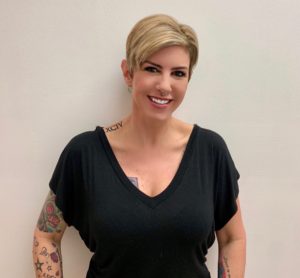The never-ending quest for clear unblemished skin may sometimes take us down an abrasive path. There is no shortage

of specialty materials, scrubs, and chemicals on the market hoping to entice us with the promise of a flawless complexion. It’s not uncommon for those promises to fall flat, leaving us with less than perfect skin and a whole lot of questions about what could have possibly gone awry.
Part of the problem is a fundamental misunderstanding of what exfoliates do, and which one might be best suited for your individual skin type. Licensed Esthetician Jennifer Christie knows first hand what can happen when you mismanage this step in your skin care routine. “You can wound your skin with a single application of the wrong product or by using the wrong technique, and it can take months to repair.” Christie suggests researching any exfoliating product before using it. “Don’t get caught up in the hype” she says, “Pretty packaging and slick advertising doesn’t mean a product will work for you.”
One of the most practical approaches is to understand your options when it comes to effective exfoliation. Christie breaks them down into three categories: Applied (professional), Physical, and Chemical.
-Dermaplane (Professional)
*usually done for purposes of hair removal, but it is also a fantastic form of exfoliation.
*the top layer of dead skin cells are removed (along with the hair) with a professional esthetic blade (scalpel).
*this process is good for clients who don’t want to use a chemical or manual scrub. Those products have the potential to irritate their skin.
*It can also be considered a fresh start each month with the proper manual or chemical exfoliant to be used at home. That decision should be made with your esthetician.
*Results include smoother and brighter skin, better absorbency of skin care products, and easy application of base makeup products.
-Manual Scrub (Physical)
*Includes any scrub that requires a rubbing action to achieve results.
*Works on the uppermost layer of skin.
*Yields immediate mild results.
*skin will be smooth and soft.
*Benefits: you don’t have to worry about a negative interaction with your other products.
*Warnings: clients often rub too harshly causing irritation. It’s important to remember that it’s the TOP layer of skin that is being exfoliated.
*scrubs that contain larger particles can cause microscopic tears in the skin.
-Acids & Enzymes (Chemical)
*Includes mild acids or enzymes like glycolic, salicylic, lactic, papain (enzyme from papaya), pineapple and coconut.
*They help dissolve the keratin (glue) the binds the dead skin cells together.
*Acids and enzymes don’t require any scrubbing.
*They initially work on the top layer, then penetrate below the skin’s surface for a progressive increase of your natural exfoliation rate.
*They can be gentler on the skin than manual scrubs, which is why they can be better for people with problematic skin.




